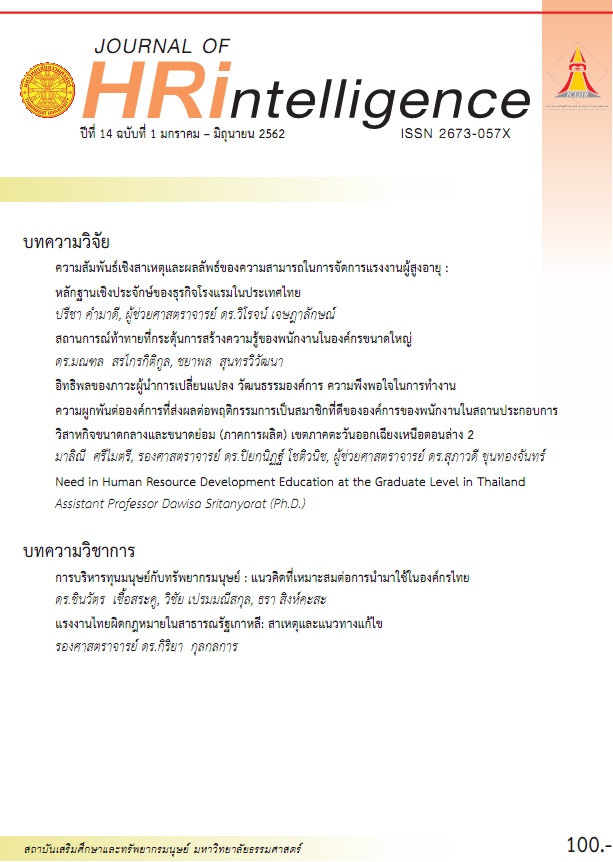ความต้องการในการศึกษาด้านการพัฒนาทรัพยากรมนุษย์ระดับบัณฑิตศึกษาในประเทศไทย
Main Article Content
บทคัดย่อ
ปัจจุบันการเรียนการสอนหรือการศึกษาในสาขาการพัฒนาทรัพยากรมนุษย์ในประเทศไทยพัฒนาการมายาวนานโดยประสานความร่วมมือระหว่างวงการวิชาการและนักปฏิบัติเป็นเวลาราว 20 ปี อย่างไรก็ตามการออกแบบและปรับปรุงเนื้อหาของการเรียนการสอนให้สอดคล้องกับบริบทและความต้องการของผู้มีส่วนได้ส่วนเสียกลุ่มต่างๆ นั้นย่อมส่งผลให้คุณภาพการเรียนการสอนดีขึ้น อีกทั้งยังเป็นการส่งมอบผู้จบการศึกษาที่มีคุณภาพตรงตามความต้องการของตลาดแรงงานและสังคม รวมถึงสร้างความเข้าใจเกี่ยวกับความต้องการของผู้มีส่วนได้ส่วนเสียอีกด้วย การศึกษาครั้งนี้มีวัตถุประสงค์เพื่อนำเสนอความต้องการที่มีต่อการจัดการเรียนการสอนด้านการพัฒนาทรัพยากรมนุษย์ในระดับบัณฑิตศึกษาในประเทศไทย การศึกษาใช้ระเบียบวิธีวิจัยแบบผสมผสานระหว่างการวิจัยเอกสาร การวิจัยเชิงคุณภาพและการวิจัยเชิงปริมาณ โดยขั้นตอนแรกคือทบทวนวรรณกรรมเกี่ยวกับหัวข้อรายวิชาในหลักสูตรสาขาการพัฒนาทรัพยากรมนุษย์ในประเทศไทย และสัมภาษณ์ผู้มีส่วนได้ส่วนเสียของหลักสูตร แล้วจึงพัฒนา แบบสอบถามสำหรับการเก็บข้อมูลเชิงปริมาณจากกลุ่มตัวอย่างซึ่งเป็นผู้มีส่วนได้ส่วนเสียกับหลักสูตรโดยใช้วิธีการวิเคราะห์ค่าเฉลี่ยและการคัดแยกปัจจัยเชิงสำรวจ พบว่าหัวข้อเนื้อหาสามารถแบ่งออกเป็น 10 หมวดหมู่ ซึ่งครอบคลุมถึงหมวดความรู้ด้านการพัฒนาทรัพยากรมนุษย์ในระดับต่างๆ อาทิระดับบุคคล ระดับองค์การ และบริบทนานาชาติ ความรู้ด้านการบริหารทรัพยากรมนุษย์ ความรู้ด้านระเบียบวิธีวิจัย ความรู้ด้านทฤษฎีฐานรากในการพัฒนาทรัพยากรมนุษย์ ความรู้ด้านการจัดการทางธุรกิจ และความรู้ด้านจริยธรรม ซึ่งสอดคล้องกับการทบทวนวรรณกรรมและมาตรฐานคุณวุฒิวิชาชีพด้านทรัพยากรมนุษย์ในประเทศไทย งานวิจัยนี้ได้ให้ข้อเสนอแนะเกี่ยวกับผลลัพธ์การเรียนรู้ที่คาดหวังของหลักสูตร HRD รวมทั้งแนวทางการออกแบบ พัฒนา และประเมินหลักสูตรเพื่อให้ตรงตามต้องการของผู้มีส่วนได้ส่วนเสีย
Article Details
ขอมอบลิขสิทธิ์บทความที่ได้รับการตีพิมพ์ให้แก่สถาบันเสริมศึกษาและทรัพยากรมนุษย์ กรณีมีการฟ้องร้องเรื่องการละเมิดลิขสิทธิ์เกี่ยวกับภาพ กราฟ ข้อความส่วนใดส่วนหนึ่ง และ/หรือข้อคิดเห็นที่ปรากฎในบทความ ให้เป็นความรับผิดชอบของข้าพเจ้าและผู้เขียนร่วมแต่เพียงผู้เดียว
เอกสารอ้างอิง
Akaraborworn, C. T. (2014). Global HR trends 2014-2015. Retrieved from https://www.manpowerthailand.com/uploads/news/filepd_1ebf629c6e4e261c5345c8114cadb515.pdf
Cooper, D. R., & Schindler, P. S. (2006). Business Research Methods. New York, NY: McGraw Hill.
Creswell, J. W., & Creswell, J. D. (2005). Mixed method research: Developments, debates, and dilemmas. In R. A. Swanson & E. F. Holton III (Eds.), Research in organizations: Foundations and methods of inquiry (pp. 315-326). San Francisco, CA: Berrett-
Koehler.
Garavan, T. M. (1997). Training, development, education and learning: Different or the same? Journal of European Industrial Training, 21(2), 39-50.
Glesne, C. (2011). Becoming Qualitative Researchers (4th ed.). Boston, MA: Pearson.
Green, D. (1994). What is quality in higher education Concept, practice and policies. In Green, D. (Ed.), What is quality in higher education? (pp. 3-19). PA: Taylor and Francis.
Greene, J. C., Caracelli, V. J., & Graham, W. F. (1989). Toward a conceptual framework for mixed-method evaluation designs. Educational Evaluation and Policy Analysis, 11(3), 255–274. doi:10.3102/01623737011003255
Hair, J. F., Anderson, R. E., Tatham, R. L., & Black, W. C. (1998). Multivariate Data Analysis (5th ed.). Upper Saddle River, NJ: Prentice Hall.
Hite, L. M., & McDonald, K. S. (2010). Perspectives on HRD and diversity education. Advances in Developing Human Resources, 12(3), 283-294. doi: 10.1177/1523422310374974
Kormanik, M. B., & Rajan, H. C. (2010). Implications for diversity in the HRD curriculum drawn from current organizational practices on addressing workforce diversity in management training. Advances in Developing Human Resources, 12(3), 367-384. doi:
10.1177/1523422310375033
Krejcie, R. V., & Morgan, D. W. (1970). Determining sample size for research activities. Educational and Psychological Measurement, 30, 607-610.
Kuchinke, P. K. (2001). HRD university education: an international research agenda. Human Resource Development International, 4(2), 253-261. doi: 10.1080/13678860010006121
Kuchinke, P. K. (2002). Institutional and curricular characteristics of leading graduate HRD programs in the United States. Human Resource Development Quarterly, 13(2), 127-144. doi: 10.1002/hrdq.1019
McDonald, K. S., & Hite, L. M. (2010). Diversity in the HRD curriculum: Concluding thoughts and next steps. Advances in Developing Human Resources, 12(3), 385-391. doi: 10.1177/1523422310375032
McGuire, D. (2010). Foundations of human resource development. Retrieved from https://www.sagepub.com/upm-data/36589_01_McGuire_CH_01.pdf.
McLean, G. N., & Akaraborworn, C. (2014). HRD education in developing countries. In D. Cho, K. Ryu, and M. Akdere (Eds.), Proceedings of the 13th International Conference of the Asia Chapter of Academy of Human Resource Development.Seoul, Korea: Academy of Human Resource Development.
McLean, G. N., & McLean, L. D. (2001). If we can't define HRD in one country, how can we define it in an international context? Human Resource Development International, 4(3), 313-326.
Na Chiangmai, C. (October, 1998). Current outlook and trends of HRD in Thailand. Paper Presented at the International HRD. University of Minnesota, St. Paul, MN.
Nadler, C., & Nadler, Z. (1992), Every Manager’s Guide to Human Resource Development. San Francisco, CA: Jossey-Bass,
Office of the National Economic and Social Development Board. (2008). The 8th National Economic and Social Development Plan. Retrieved from https://www.nesdb.go.th/Default.aspx?tabid=90.
School of Human Resource Development National Institute of Development Administration. (2013). Master of Science Program in Human Resource and Organization Development (Version B.E. 2556). Retrieved from
https://www.hrd.nida.ac.th/hrodnida/rtefile/rte_690.pdf.
Society for Human Resource Management. (2015). Evolution of work and the worker: Five key trends from SHRM’s special expertise panels. Retrieved from https://www.shrm.org/about/foundation/products/Documents/2015%20Evol%20of%20Work-
Panel%20Report-FINAL.pdf.
Sritanyarat, D., & Russ-Eft, D. (2016). Empirical evaluation indicators in Thai higher education: Theory-based multidimensional learners’ assessment, International Journal of Instruction, 9(2), 3-18. doi: 10.12973/iji.2016.921a
Swanson, R. A. (1995). Performance is the key. Human Resource Development Quarterly, 6(2), 207-213.
Tam, M. (2001). Measuring quality and performance in higher education. Quality in Higher Education, 7(1), 47-54, doi: 10.1080/13538320120045076.
Thailand Human Resources Certification Institute. (2016). HR Occupational Standard Model. Retrieved from https://www.pmat.or.th/hrci/index.php


